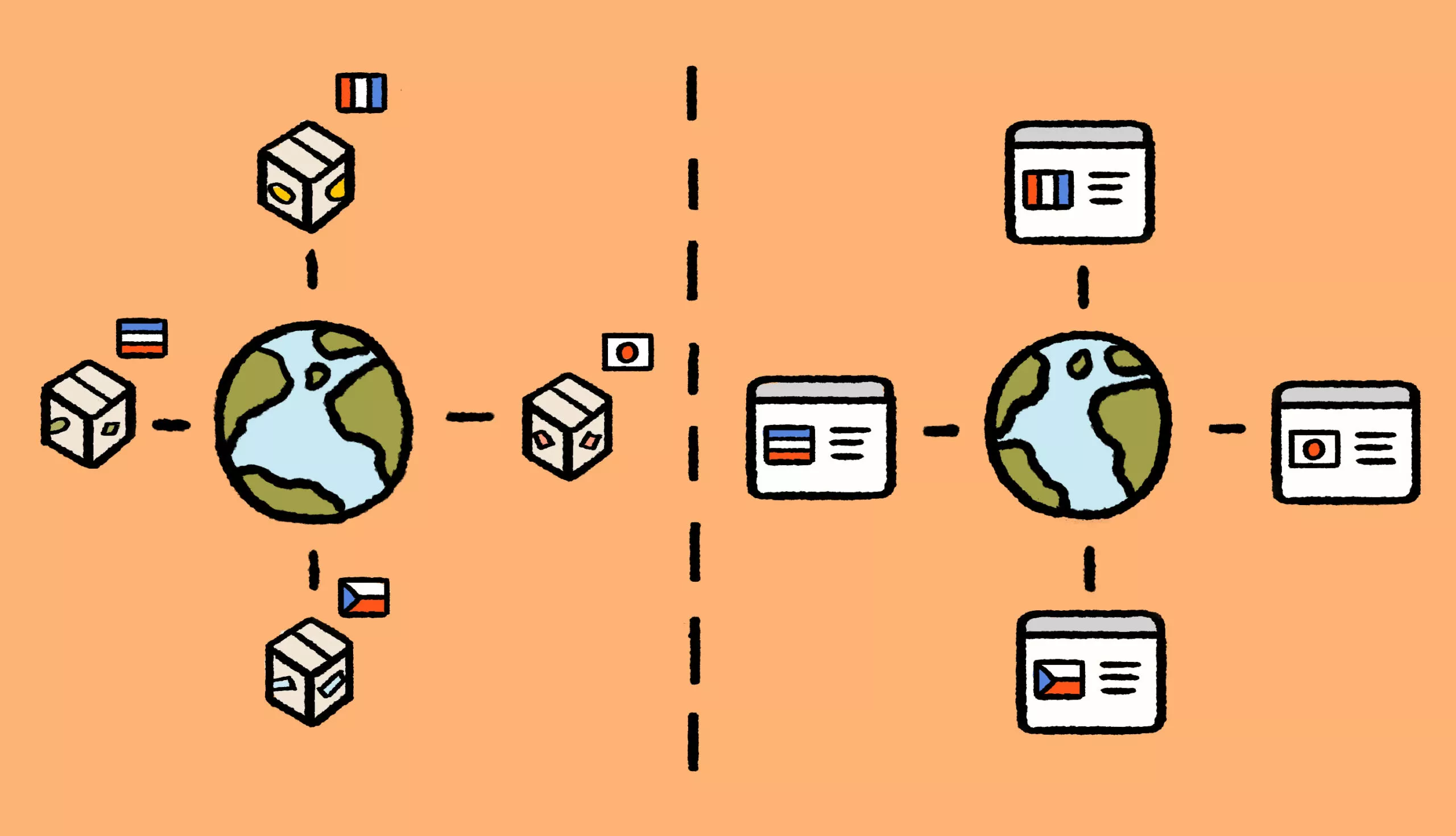Globalization vs. localization—two sides of the same coin, right? But when shaping a product or marketing strategy, you might ask yourself:
Given the impact of globalization, should I go global, or should I tailor the approach to individual markets?
The thing is, it’s not really an either/or situation. It’s about knowing when to think globally and when to adapt locally. An effective localization process allows companies to refine their global strategies by integrating local preferences and cultural nuances, ensuring that their offerings resonate with diverse audiences. This is especially true for businesses looking to scale.
So, what does globalization vs. localization really mean, and how can these two approaches work together to fuel business growth? Let’s break it down.
💪 Actionable insights
This article provides an overview of globalization vs. localization, with examples that help you gain a deeper understanding of the two approaches. It also includes a list of questions you can use to decide if you should go with globalization or localization when expanding to international markets.
Globalization vs. localization: main differences
Think of the biggest companies you interact with every day – Google, Microsoft, Amazon, Netflix, and so on. You’d say they’re all “global,” offering a consistent customer experience to people the world over. And you’d be right.
But here’s the thing: they’re also among the most localized companies out there. Confusing a bit? Let’s have a closer look.
Global outlook, local needs
These tech giants offer products and services in many different countries. Their global marketing strategy allows them to maintain brand values, look, and feel across global markets, while still adjusting to meet the expectations of local cultures.
The product experiences are subtly different from country to country. Let’s take Windows OS for example.
Microsoft’s Windows OS is both localized and globalized.
The core version of Windows, including its architecture, features, and design, is created to be used worldwide. This ensures consistency across different regions, so the Windows experience is essentially the same no matter where it’s used.
But despite having a global foundation, Windows is adapted for individual markets through localization. This includes translating the user interface into different languages, adjusting date, time, and currency formats, supporting region-specific keyboards, and incorporating local regulations or standards where necessary. This process highlights the importance of software internationalization, which ensures that the core code can easily be adapted to various languages and regional preferences without requiring significant reengineering.
✏️ Key takeaway
Localization helps Windows feel native to users in different countries and cultures, making it easier to use. However, the globalized approach simplifies updates, security patches, and user support. Keep this in mind as you figure out what would be the best for your product launch in different regions.
Getting that enterprise mindset
So, these companies have a global vision for what they want to sell… but they also want to customize those products and services for local audiences, to maximize their market opportunity in each area.
If localization is up close and personal, understanding the subtle nuances that separate local cultures, globalization is the bird’s-eye view. It’s the “enterprise mindset” that decides what you want to be known for and the common factors that all audiences share.
Apply both strategies for success
In many cases, “going global” demands local smarts, too. Globalization and localization are different sides of the same coin. So make sure you understand both – whether you’re enterprise-scale, enterprise-ready, or enterprise-someday.
What is localization?
Localization is the process of adapting your products and services to the specific conditions of a specific market with a shared culture and values. So, what is localization? While that includes language, localization does not stop with translation. It’s much bigger than that.
The best approach takes note of culture, idioms, figures of speech: think of the differences between the Spanish spoken in coastal Spain, Los Angeles, and rural Mexico.
Factors of localization
The goal of localization is content that “feels right” to people in the market you’re addressing. With language, it’s the subtle word choices that create a sense of comfort among consumers. Then they know you understand them. And that extends to brand values.
Cultures vary in what they consider positive and meaningful. A brand claim that hits the mark in the United States may fall flat in Japan. A great translator is as much artist as linguist.
Going beyond translations
Localization is not limited to words, either. Visuals, patterns, and even colors carry different appeal from country to country. Look around the world, and you’ll see small but significant changes in the way a brand presents itself, from photography to fonts; all these are part of an effective localization rollout.
Take Coca-Cola’s website, for example.

Coca-Cola’s website in the United States emphasizes current limited edition of Coca-Cola

Coca-Cola’s website in Japan allows the target demographic to identify with the photograph
As you can see, both websites are tailored to the cultural preferences of each respective market.
Other factors are easier. The way dates, times, and currencies are written; the weights and measures familiar to an audience; the style guides in use by mass media all have an impact. Small things, perhaps – but they add up to big differences.
Globalization vs. localization in the context of product experience
And then there’s the user interface, or UI. “Reading gravity” – the way a person’s eye moves across a page – is different around the world.
Many Chinese languages prefer top to bottom over left to right, while both China and Japan start their books on what Europeans see as the last page.
These preferences have a place in how websites and applications are designed, too. And they start small: if your “Submit” button is too short to contain the word once it gets translated into different languages, then you have a user experience issue.
📚 Further reading
To learn more about prepping your product for localization, see the article on globalization vs internationalization.
Localization is a 360° view of culture
So, localization goes beyond words: it’s not just language, but broader culture. It’s a deep understanding of a population with the same everyday experiences – and knowledge of what’s needed to make your products and services play in its competitive landscape. It’s far from easy. But for companies with a global outlook, localization pays dividends.
What is globalization?
Globalization is different. Globalization is the process of expanding business operations on a worldwide scale, while localization is the process of adapting products, services, and marketing to meet the specific needs of local markets.
It’s more worldview than local know-how, more business mindset than cultural commentator. It comes down to answering this question:
Do you want to be a niche player, addressing a rare pain point for a single group of people… or do you want your name to be known by millions worldwide, as a trusted brand across borders, cultures, and continents?
Globalization starts in the corner office and goes on the front page of the strategic plan. It’s a deliberate decision to create products and services with global appeal, and to make the same basic brand promise to a wide variety of markets.
The way you communicate that promise might differ by market – and that’s where localization comes in. But globalization is the big idea – your overarching goal for the future.
✏️ Key takeaway
Where localization explores the differences between cultures, globalization is about finding similarities.
Factors of globalization
Of course, the primary driver of globalization is making more money. Every entrepreneur dreams of success at scale, being number one in multiple markets worldwide. But other reasons exist.
Like this: the more you sell, the less you spend making each product. Economies of scale drive many globalization strategies; when development costs are amortized across a million SKUs instead of a thousand, prices can be more competitive and profits higher. Globalization is good for the bottom line.
Another advantage of globalization is a simplified portfolio. Cars look different around the world – but many share the same basic floor plans and engines, reused across markets for efficiency. Swatch watches come in thousands of varieties – but all are identical behind the face. A global outlook sees such opportunities for standardizing products and processes, and takes them.
And when your risk is spread across different markets, you’re diversified, no longer reliant on your home market. It’s a goal of every global enterprise, from the industrial era to today’s information-driven economy.
Globalization: success, squared
Globalization is treating the world as your marketplace, and finding ways to sell to it. The takeaway here: by applying a global strategy at the local level in each market, you win either way.
Pros and cons of globalization and localization
It’s clear by now that globalization and localization work together. So to finish, let’s look at what happens if you limit yourself to just one of them.
Global dreams, no local knowledge
Some companies can succeed by selling the same product (almost) everywhere – take the iPhone. But Apple is a rare globalization example. The business end of an iOS device – the user interface – is, of course, a lot more localized than many imagine.
So a purely global outlook, without adaptation to each market, is unlikely to put you in the Fortune 500.
You can make the best chat/commerce app in the world, but it won’t have appeal beyond its home market if it’s only available in Chinese. And it’s not limited to technology: rice, cheese, and even chocolate are far from universal staples. (Well, we’d like chocolate to be a staple, anyway).
💡 Pro tip
Want to hear a trade secret? No product is the same everywhere, and you should take this into account as you formulate your market expansion strategy.
Local focus, limited horizons
However, an approach that never gets beyond the local has problems, too. A product strategy of designing a different product tailored to each market carries zero economies of scale; even worse, it leads to a bloated product portfolio and high complexity in your supply chains. Such a company isn’t really international; it’s a whole set of different companies without much in common.
See the issue here? Globalization and localization are both great strategies for international expansion, especially when used together. The whole is greater than the sum of its parts.
Do both with Lokalise
That’s what Lokalise does; it provides you with a platform for both localization and globalization, both sides of the same coin. Why not see how it works for yourself, with this 14-day free trial?






